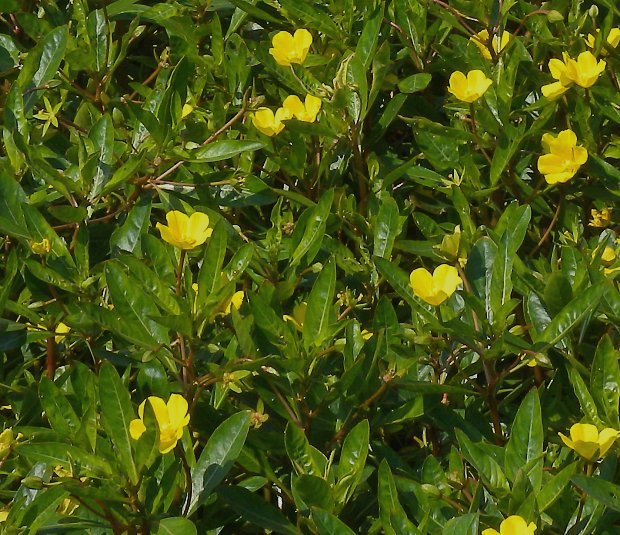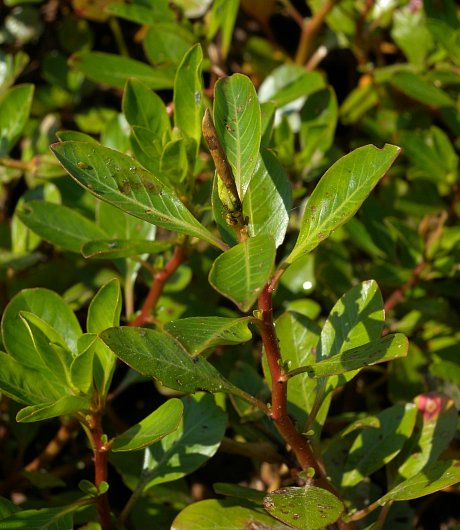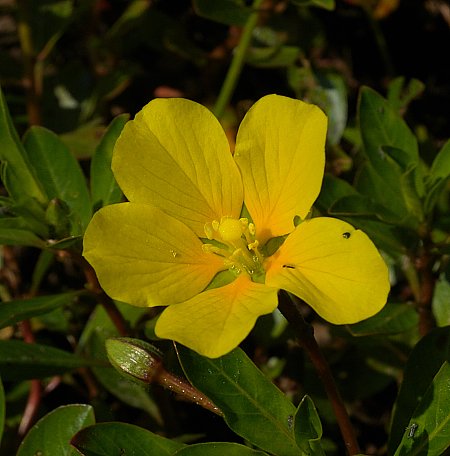Creeping
Water Primrose
Ludwigia peploides
glabrescens
Evening Primrose family (Onagraceae)
Description:
This perennial plant is ¾–2½' long. It either floats on water or
sprawls across the ground. The stems are light green to red (often the
latter), glabrous to sparsely pubescent, and terete. Alternate leaves
along these stems are 1¼–3" long and ½–1" across; they are elliptic,
oblong-elliptic, oblanceolate, or oblong-oblanceolate in shape and
smooth along their margins. The leaves are usually glossy green in
appearance, although sometimes they develop patches of red or yellow.
The upper leaf surface is glabrous, while the lower leaf surface is
glabrous to sparsely pubescent. The leaf bases taper gradually
into slender petioles about ½–2" long. Individual flowers develop
from the axils of the middle to upper leaves on erect to semi-erect
pedicels about 1–3" long. Each flower is about 1" across, consisting of
5 yellow petals, 5 light green sepals, 10 yellow stamens, and a
narrowly cylindrical pistil with a single style. The petals are obovate
in shape with pale pinnate nerves, while the smaller sepals are
lanceolate. Compared to the size of the flower, both the stamens and
style are relatively short. Between the apex of the pedicel and the
bottom of the pistil, there is a pair of tiny bractlets (about 1.0–1.5
mm. in length). The blooming period occurs from late spring to early
fall, lasting several months. The flowers are diurnal.

Afterwards,
the flowers are replaced by
cylindrical seed capsules about 1–1½" long. Each seed capsule has 5
narrow cells, and each cell contains a row of seeds. The seeds are
enclosed in chunky outer coatings (endocarps); they are about 1.0-1.5
mm. in length. The root system is fibrous and fleshy. When the nodes of
the stems lie on wet ground, they are capable of developing new fibrous
roots, from which new plants are produced vegetatively. Sometimes the
root system produces small bladders that keep individual plants more
buoyant in the water. This plant often forms large colonies.
Cultivation:
The preference is full sun, wet conditions, and muddy soil, although
this plant can adapt to shallow water as a floating aquatic.
Creeping Water Primrose (Ludwigia
peploides glabrescens) can spread
aggressively in shallow wetlands and muddy areas. It is potentially
invasive.

Range
& Habitat: Creeping Water Primrose is
locally common and native to southern Illinois, while in the rest of
the state it is uncommon and probably adventive in most areas (see
Distribution
Map).
This
species is slowly spreading northward. Habitats include borders of
ponds, shallow areas of lakes, sluggish streams, swamps, marshes, and
ditches. In some of these habitats, Creeping Water Primrose can become
the dominant shoreline plant, forming large colonies.
Faunal
Associations: The flowers are cross-pollinated primarily
by bees,
including honeybees, digger bees (Eucerine), and Halictid bees.
Other visitors, such as flies and skippers, are less effective at
cross-pollination. These insects obtain nectar and/or pollen from the
flowers. Some insects feed destructively on Creeping Water Primrose.
This includes the flea beetles,
Altica
litigata and
Lysathia
ludoviciana,
and a leafhopper,
Draeculacephala
inscripta. The Mallard
and possibly other ducks feed on the seed capsules. Because of the
large dense colonies that this plant often forms, it provides good
cover along shorelines for various insects, frogs, and other wetland
wildlife.

Photographic
Location:
Muddy shore of a pond in southern Illinois.
Comments:
Creeping Water Primrose has showy flowers and attractive foliage.
Unfortunately, it is sometimes too aggressive for its own good. It can
be distinguished from other Ludwigia
spp. by its larger 5-petaled
flowers and sprawling semi-aquatic habit. Across its range in the
United States and tropical America, different varieties of this species
have been described, although only var.
glabrescens has been found in
Illinois. This variety can be distinguished by its more glabrous
foliage. Another scientific name of this wetland plant is Jussiaea repens glabrescens,
while an alternative common name is Creeping Primrose Willow.



